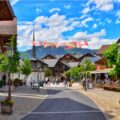Traditionally, a Swiss holiday is invariably around cheese, chocolates or mountains. The lush green pastures and crisp mountain air is what draws many of us there. I also suspect that for most of us in India the dreamy Yash Raj Productions have a significant role to play here!
But there is a side of Switzerland that rarely takes centre stage – its history, both medieval and recent. Having spent three weeks traversing the country recently, I have been able to uncover many such hidden gems that have contributed to the evolution of the country to what you see today.
A visit to these historical places in Switzerland helps you understand how history shaped the country’s geography, and technology changed its topography. You will find that Switzerland is still soaked in traditions but embraces the changes that modern times bring with open arms.
Unknown to many, there is an ancient heartland in Switzerland that is often lost in the glitzy and glamorous boutiques of Zurich and Geneva or the peaks of Jungfraujoch and Mt. Titlis. Getting to this heartland is what adds a new dimension to an otherwise typical Swiss holiday.

Museum of Horology, La Chaux-de Fonds
Considered the hub of watch-making, in Switzerland, there is a whole town in the Jura mountains that was set up around this craft in the 16th century. Even today, La Chaux-de-Fonds has numerous firms and artisans working in its few quiet corners, making the most exclusive of watches on the planet.
It is, therefore, an apt place for the location of Musée International d’ Horlogerie, a museum dedicated to the art of watch-making. An interactive space, the museum houses intricately designed pieces from the moment timekeeping started until its modern days.
Inside this truly exceptional contemporary building, visitors will find the world’s most diverse collection of watches and clocks. Each one of the timepieces is beautifully exhibited with details of its functioning and origin mentioned alongside. Once there, tourists can choose to be an observer or use some of the interactive pieces to get a better understanding of the art that makes watch-making such a delicate profession.
While in Switzerland, make sure you plan a visit to a Swiss watch maker’s atelier. It is the perfect opportunity to go behind the scenes and experience the fascinating process of watch-making first hand.

Salt Mines, Bex
Although it may feel like a fun ride in a theme park, riding the train into the 800m deep salt mines at Bex is the real deal. The train connects a labyrinth of 50,000m of underground tunnels that house wells and galleries showcasing the story of salt mining which started here in the late 1600s.
Given their love for the mountains, it is no surprise that the Swiss have managed to dig so deep to extract salt that has been buried underground for more than 200 million years.
Built right inside the oldest salt mine in the country, this fascinating attraction arranges guided tours giving educational insights into the history of the white gold (salt) and the mining done here.
The Bex mines are still fully operational, although the salt concentrations are some of the lowest in the world. The tunnels are located about 45min from Lausanne and are an easy day trip.

Gandria – the last Swiss village before the Italian border
Gandria is the last Swiss village on the border with Italy near Lugano. Sitting on the northern shore of Lake Lugano, it’s a charming historic town with narrow cobbled alleyways and cute little buildings tightly packed together, making for a picture-perfect setting.
Some of these buildings date back to the 16th century when the village was known for its olive trees and oil production. Unfortunately, all of these trees were destroyed in the frigid winter of 1709 and could never grow again.
Today, some remains are visible on a hike called the Sentiero de Gandria. Running along the lake, the trail hugs olive growing hills. A typical Mediterranean flora that includes century-old olive trees, laurel oaks, cypresses, and myrtles welcomes you on this adventurous journey.
It is on this trip that you also come across a long line of connected buildings that have defied time, and cellars where residents used to store wine, cheese, and cured meats before the ease of refrigeration. Some of these cellars are now taverns that are a welcome respite through the hike.
Also, closeby is an intriguing Swiss Customs Museum. As the name suggests, it displays in life-size installations, the methods used and challenges faced by the Swiss Customs officials. Located along the lake, it is situated in an old border post and boasts a beautiful view of Gandria through its viewing gallery.

Chur – Switzerland’s oldest town
With a settlement dating back 5000 years, Chur is one of the oldest towns in Switzerland. Filled with a cluster of historic buildings, the traffic-free village is surrounded by the Alps on all sides, and is more than just your gateway to the glamourous St. Moritz.
Chur has among the best-preserved Old Town in the country which forms a backdrop for colourful weekend markets in the summer. The St. Martin’s Church here has become a landmark with its distinctive spire. For a peek into the history of the town and the region, a visit to the Rätisches Museum is highly recommended.
A walk through the old town is like walking through a vibrant gallery taking you through beautiful boutiques, heritage buildings, traditional restaurants, and relaxed bars. As a result, Chur serves as a great base to relax for a couple of days before heading higher into the Alps.

After visiting the town and absorbing its charm, you can hop on the Bernina Express that departs from Chur down to Torino, Italy. The train passes some breathtaking views along the Swiss Engadin Alps and also runs by the World Heritage Site of Rhaetian Railway in the Albula / Bernina pass.
While Switzerland offers spectacular natural beauty and world-class adventure activities, such cultural symbols that form the fabric of this country add to its more endearing vintage charm.
Photos – Author and Unsplash





